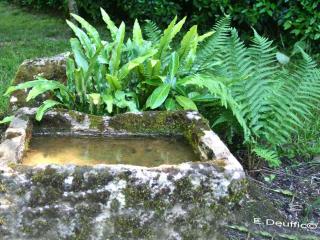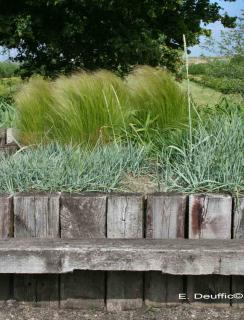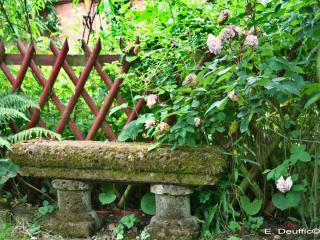

The best of gardens share an irresistible invitation to passersby, beckoning them to sit for a spell, perhaps daydream for an instant. A simple piece of furniture, be it bench, chair, statue, a smooth slab of rock placed at the right spot by human hands, all beget meaning.
Nestled into the surrounding nature, such objects greatly enhances a place’s charm.
Among garden furniture, stone is the material that best blends both with architecture (house, pavement, stairs, retaining walls…) and vegetation. A bench set in a green setting becomes a spot for contemplation, reading, or meditation.
Stone offers coolness; damper sides of a bench even harbor moss which, in time, takes root. It of course is the symbol of durability. Some criticize its “steadfastness”, as it isn’t easily transportable. Stone is a bit pricey, yet great opportunities can be gotten with building demolishers and salvagers. Repurposing built elements, like stone stairways steps or grain grinding wheels, as garden furniture adds an undeniable touch of authenticity.

Today, great achievements are possible thanks to reconstituted stone. Crushing rock and combining it with a cement-like binder lets us mold shapes that are perfect replicas of old carved stone pieces. The quality is simply astonishing. Time adds its patina just as it would real stone, causing a slight erosion along the surface and giving them a rich, noble texture.
Wood is increasingly popular in garden designs for fences, decks, and pergolas. When abusively extracted from nature, it has grave downsides: decay-resistant wood often comes from exotic species exploited in uncontrolled tropical deforestation. Happily, sustainable plantations now produce more and more of the wood found in stores, but these faster-growing trees tends to be slightly less durable than those sourced from the wild.

European woods like pine and fir become decay-resistant after a chemical treatment, which gives a greenish tint. Scientists are exploring greener, non-toxic methods like the recently patented Wood Protect® process by Inra-Lapeyre. It’s a chemical process that uses natural, non-toxic agents on fir wood.
Another technique is wood torrefaction, which is a High-Temperature Treatment that helps wood take on the decay-resisting properties of charcoal. The latter holds great promise for garden furniture.
Wood is heated in an airtight oven at 400-500°F (200-270°C) under controlled pressure. Steam is injected to prevent ignition. This causes the fibers to resist decay and tints the wood a lovely caramel hue. It also releases a faint scent of gingerbread.
This method works for many wood types: spruce, fir, maritime pine, Douglas fir, Scots pine, poplar, beech, ash, birch, and more. Unfinished, the wood turns silver-gray over time. Its only drawback is reduced strength. This is easily offset by simply using thicker planks.
Don’t forget about the natural durability of trees native to our regions like chestnut and false acacia. Their wood resists rot incredibly well, even when buried. Acacia posts, for instance, are common in coastal oyster farms and vineyards.
Be cautious, though, with old railway sleepers when retaining soil. Soaked in carbonyl and stained with tar, skin contact should be avoided because of carcinogenic substances. They still leach out from wood even 25 years later! Best is to go for new beams made of pine or larch treated in an eco-friendly manner. Or, get creative with reconstituted stone that looks just like wood!
